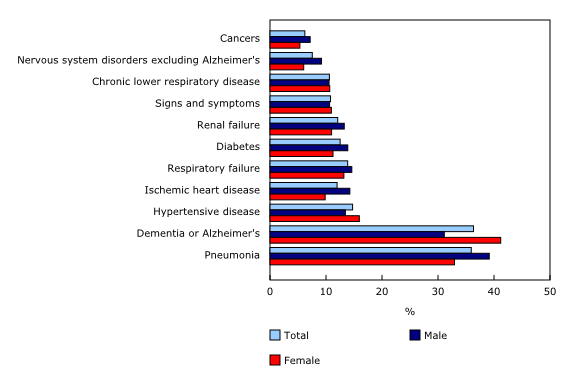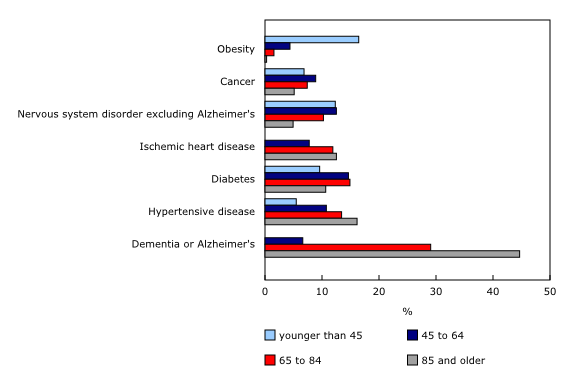Provisional death counts and excess mortality, January 2020 to February 2021
Archived Content
Information identified as archived is provided for reference, research or recordkeeping purposes. It is not subject to the Government of Canada Web Standards and has not been altered or updated since it was archived. Please "contact us" to request a format other than those available.
Released: 2021-05-14
COVID-19 continues to affect communities and families in Canada. Beyond deaths attributed to the disease itself, the pandemic could also have indirect consequences that increase or decrease the number of deaths as a result of various factors, including delayed medical procedures or increased substance use.
To understand both the direct and indirect consequences of the pandemic, it is important to measure excess mortality, which occurs when there are more deaths during a period of time than what would be expected for that period. It should be noted that, even without a pandemic, there is always some year-to-year variation in the number of people who die in a given week. This means that the number of expected deaths should fall within a certain range of values. There is evidence of excess mortality when weekly deaths are consistently higher than the expected number, but especially when they exceed the range of what would be expected over consecutive weeks.
As part of Statistics Canada's commitment to providing timely and relevant information on COVID-19 and its impact on Canadians, a new updated provisional dataset from the Canadian Vital Statistics Death Database, covering the period from January 2020 to February 2021 has been released today. Updates were also made to the provisional death estimates, which have been adjusted, where possible, to account for the incomplete nature of the counts. The provisional estimates will continue to be revised in future releases as more information is reported by provincial and territorial vital statistics agencies and as methods continue to be enhanced.
From January 2021 to early February 2021, there were 31,509 deaths in Canada. This amounts to 2.1%, or 658, more deaths than expected if there were no pandemic, after accounting for changes in the population, such as aging. While some of these excess deaths may be related to indirect effects of the pandemic or other unrelated factors, they are still largely explained by the deaths attributed directly to COVID-19.
The risk of severe outcomes due to COVID-19 varies depending on individual vulnerabilities. One of these susceptibilities is pre-existing health conditions. The Public Health Agency of Canada has advised that certain pre-existing conditions such as diabetes, chronic obstructive pulmonary disease, cancer and heart disease put individuals at higher risk of severe illness or death from COVID-19. In addition, the suggested Canadian vaccination rollout prioritizes vulnerable populations, including those with underlying conditions. The provisional data released today confirm that about 9 out of 10 Canadians who have died of COVID-19 had at least one other condition or complication, or comorbidity, reported on their medical certificate of death.
Almost 90% of people who died of COVID-19 in 2020 had a least one other comorbidity
Of the nearly 15,300 people who died of COVID-19 between March and December 2020, 89% had one or more other conditions or complications reported on their death certificate. In fact, almost two-thirds (65%) had two or more comorbidities and almost half (46%) had three or more comorbidities reported. These results, along with the specific conditions listed on the death certificate, highlight some of the populations in Canada most vulnerable to severe outcomes of COVID-19. Although individuals had pre-existing conditions, it does not imply that they were at risk of dying if there had been no COVID-19 infection.
Dementia or Alzheimer's is the most common comorbidity associated with deaths due to COVID-19
Of all COVID-19 deaths in 2020, dementia or Alzheimer's was reported on 36% of COVID-19 death certificates. However, the frequency with which it was reported varied between women and men. It was the most common comorbidity among women, reported on 41% of records, whereas for men, it was the second most common comorbidity, reported on 31% of records. These results can be partly explained by the age and sex profile of Canadians who died of COVID-19 in 2020: 63% of women who died of COVID-19 were older than 85, whereas 47% of men who died of COVID-19 were older than 85. According to the Public Health Agency of Canada, about 1 in 4 Canadians aged 85 or older live with dementia or Alzheimer's.
Other common COVID-19 comorbidities reported on death certificates included pre-existing cardiovascular and respiratory conditions such as hypertensive diseases (15%), ischemic heart disease (14%) and chronic lower respiratory diseases (11%).
In addition to pre-existing conditions, comorbidities such as pneumonia and respiratory failure were also commonly reported. These, however, can also be the result of COVID-19 rather than underlying reasons why the individual had a severe COVID-19 outcome.
The prevalence of specific comorbidities varies with age
Since 94% of Canadians who died of COVID-19 in 2020 were older than 65, the overall trends for common COVID-19 comorbidities are largely driven by age. However, comorbidities were clearly present in the majority of COVID-19 deaths regardless of age.
For younger populations who died of COVID-19, diabetes was a common pre-existing condition reported on the death certificate. In fact, 15% of COVID-19 deaths among the 45-to-84 age group also had diabetes reported on the death certificate. This was lower for those younger than 45, with 9% of those who died of COVID-19 also having diabetes reported. However, given that, according to the 2019 Canadian Community Health Survey, 6% of Canadians younger than 49 have diabetes, this highlights the elevated risk facing younger populations with underlying conditions.
Another pre-existing comorbidity that was frequently reported on COVID-19 death certificates for individuals younger than 65 was nervous system disorders, such as Parkinson's or amyotrophic lateral sclerosis diseases (excluding Alzheimer's), with 13% among those in the 45-to-64 age group and 12% among those younger than 45.
Obesity was also frequently reported among COVID-19 deaths in the younger-than-45 age category. It should be noted that, in 2020, there were fewer than 100 deaths due to COVID-19 in this age group.
The emergence of COVID-19 variants of concern and the rollout of COVID-19 vaccination strategies in Canada will likely result in further changes to the dynamics of the COVID-19 pandemic. According to a recent media report that analyzed surveillance data from the Public Health Agency of Canada, there is evidence that, as vaccination rates among those aged 80 and older are increasing, the number of COVID-19 deaths among this age group is decreasing. To better understand the evolving impacts of the pandemic on mortality in Canada, Statistics Canada will continue to provide timely information on a regular basis on excess deaths, causes of death and comorbidities as it becomes available.
Note to readers
In Canada, the Canadian Vital Statistics Death Database (CVSD) is the authoritative source for cause of death data, including COVID-19 deaths. In addition to identifying the underlying cause of death, the CVSD also includes information on the contributing causes and conditions (or comorbidities). In the context of a death caused by COVID-19, these comorbidities include diseases or conditions such as diabetes or hypertension that likely put those individuals at higher risk of death from COVID-19. While there may be challenges associated with the distinction between chronic conditions and other causes, and the nature of these with respect to COVID-19, the CVSD data provide additional insight on COVID-19-related deaths.
This analysis does not consider the relationship between the comorbidities listed on death certificates for deaths due to COVID-19. It is difficult to determine from the death certificate whether the condition was pre-existing or whether it resulted from a complication due to COVID-19.
Some deaths may have involved COVID-19 but were ultimately attributable to another disease such as ischemic heart disease, or an accidental injury such as a fall. COVID-19 is not considered as the underlying cause of these deaths, but the virus was reported as being present on the medical certificate of death, either as a contributing cause or condition.
Nevertheless, COVID-19 was identified as the underlying cause of death in the vast majority (91%) of cases where COVID-19 was reported on the medical certificate (15,360 of the 16,945 the COVID-19-involved deaths).
More information on the certification and classification of COVID-19 deaths can be found in the study, "COVID-19 death comorbidities in Canada."
About 12% of provisional information on causes of death for the reference period from January 2020 to February 2021 is unknown or pending investigation. For this reason, among others, the number of COVID-19 deaths published today may differ from the surveillance figures compiled by the Public Health Agency of Canada. More information on the two sources is provided in the article, "Provisional death count and excess mortality, January to August 2020 ."
The provisional figures on the number of deaths, the causes of death and excess mortality will continue to be updated as more information is reported to Statistics Canada by the provinces and territories and as further enhancements are made to the estimation models. More information on excess mortality during the COVID-19 pandemic in Canada is available in the article, "Excess mortality in Canada during the COVID-19 pandemic."
A number of different reference period have been used in this article:
- References to the period of 2020, are to the period from January 1 to December 31, 2020. Excess deaths and COVID-19 deaths in Canada did not become prevalent until March 2020—which is when both excess deaths and COVID-19 deaths began to be tallied.
- References to the period from January 2021 to February 2021 are to the period from the week ending January 9, 2021, to the week ending February 6, 2021.
Products
To facilitate the identification of trends in excess deaths by province and territory, the interactive visualization tool "Provisional weekly estimates of the number of deaths, expected number of deaths and excess mortality: Interactive Tool" has been updated.
To facilitate the identification of trends in the number of weekly deaths by age group and sex and by province and territory, the interactive visualization tool "Provisional weekly death counts: Interactive tool" has also been updated.
Contact information
For more information, or to enquire about the concepts, methods or data quality of this release, contact us (toll-free 1-800-263-1136; 514-283-8300; STATCAN.infostats-infostats.STATCAN@canada.ca) or Media Relations (613-951-4636; STATCAN.mediahotline-ligneinfomedias.STATCAN@canada.ca).
- Date modified:



